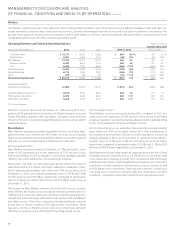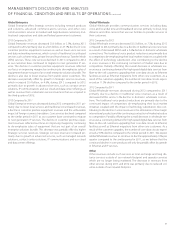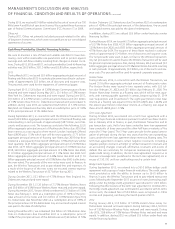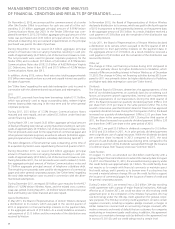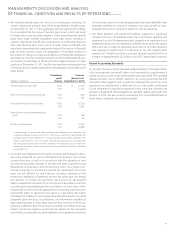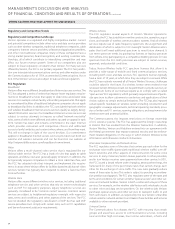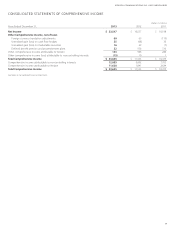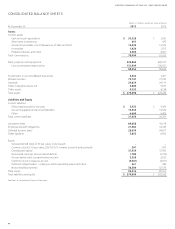Verizon Wireless 2013 Annual Report Download - page 32
Download and view the complete annual report
Please find page 32 of the 2013 Verizon Wireless annual report below. You can navigate through the pages in the report by either clicking on the pages listed below, or by using the keyword search tool below to find specific information within the annual report.
30
ered current and expected future economic conditions, current and
expected availability of wireless network technology and infrastructure
and related equipment and the costs thereof as well as other relevant
factors in estimating future cash ows. The discount rate represented
our estimate of the weighted-average cost of capital (WACC), or
expected return, that a marketplace participant would have required
as of the valuation date. We developed the discount rate based on our
consideration of the cost of debt and equity of a group of guideline
companies as of the valuation date. Accordingly, our discount rate
incorporated our estimate of the expected return a marketplace par-
ticipant would have required as of the valuation date, including the
risk premium associated with the current and expected economic
conditions as of the valuation date. The terminal value growth rate
representedourestimateofthemarketplace’slong-termgrowthrate.
Goodwill
At December 31, 2013, the balance of our goodwill was approximately
$24.6 billion, of which $18.4 billion was in our Wireless segment and
$6.2 billion was in our Wireline segment. Determining whether an
impairment has occurred requires the determination of fair value
of each respective reporting unit. Our operating segments, Wireless
and Wireline, are deemed to be our reporting units for purposes of
goodwill impairment testing. The fair value of Wireless signicantly
exceeded its carrying value and the fair value of Wireline exceeded its
carrying value. Accordingly, our annual impairment tests for 2013, 2012
and 2011 did not result in an impairment.
The fair value of the reporting unit is calculated using a market
approach and a discounted cash ow method. The market approach
includes the use of comparative multiples to corroborate discounted
cash ow results. The discounted cash ow method is based on the
present value of two components—projected cash ows and a ter-
minal value. The terminal value represents the expected normalized
future cash ows of the reporting unit beyond the cash ows from
the discrete projection period. The fair value of the reporting unit is
calculated based on the sum of the present value of the cash ows
from the discrete period and the present value of the terminal value.
The estimated cash ows are discounted using a rate that represents
our WACC.
Critical Accounting Estimates
A summary of the critical accounting estimates used in preparing our
nancial statements is as follows:
• Wireless licenses and Goodwill are a signicant component of our con-
solidatedassets.Bothourwirelesslicensesandgoodwillaretreatedas
indenite-lived intangible assets and, therefore are not amortized, but
rather are tested for impairment annually in the fourth scal quarter,
unless there are events or changes in circumstances during an interim
period that indicate these assets may not be recoverable. We believe
our estimates and assumptions are reasonable and represent appro-
priate marketplace considerations as of the valuation date. We do not
believe that reasonably likely adverse changes in our assumptions and
estimates would result in an impairment charge as of our latest impair-
ment testing date. However, if there is a substantial and sustained
adverse decline in our operating protability, we may have impairment
charges in future years. Any such impairment charge could be material
to our results of operations and nancial condition.
Wireless Licenses
The carrying value of our wireless licenses was approximately $75.7
billion as of December 31, 2013. We aggregate our wireless licenses
into one single unit of accounting, as we utilize our wireless licenses
on an integrated basis as part of our nationwide wireless network.
Our wireless licenses provide us with the exclusive right to utilize
certain radio frequency spectrum to provide wireless communication
services. There are currently no legal, regulatory, contractual, competi-
tive, economic or other factors that limit the useful life of our wireless
licenses. In 2013, we performed a qualitative impairment assessment
to determine whether it is more likely than not that the fair value of
our wireless licenses was less than the carrying amount. As part of
our assessment we considered several qualitative factors including
the business enterprise value of Wireless, macroeconomic conditions
(including changes in interest rates and discount rates), industry and
marketconsiderations(includingindustryrevenueandEBITDAmargin
projections), the projected nancial performance of Wireless, as well as
otherfactors.Basedonourassessmentin2013,wequalitativelycon-
cluded that it was more likely than not that the fair value of our wireless
licenses signicantly exceeded their carrying value and therefore, did
not result in an impairment.
In 2012 and 2011, our quantitative impairment test consisted of com-
paring the estimated fair value of our wireless licenses to the aggre-
gated carrying amount as of the test date. If the estimated fair value
of our wireless licenses was less than the aggregated carrying amount
of the wireless licenses then an impairment charge would have been
recognized. Our annual quantitative impairment tests for 2012 and
2011 indicated that the fair value signicantly exceeded the carrying
value and, therefore, did not result in an impairment.
In 2012 and 2011, using a quantitative assessment, we estimated the
fair value of our wireless licenses using a direct income based valua-
tion approach. This approach uses a discounted cash ow analysis to
estimate what a marketplace participant would be willing to pay to
purchase the aggregated wireless licenses as of the valuation date. As
a result we were required to make signicant estimates about future
cash ows specically associated with our wireless licenses, an appro-
priate discount rate based on the risk associated with those estimated
cash ows and assumed terminal value and growth rates. We consid-
MANAGEMENT’S DISCUSSION AND ANALYSIS
OF FINANCIAL CONDITION AND RESULTS OF OPERATIONS continued
CRITICAL ACCOUNTING ESTIMATES AND RECENT ACCOUNTING STANDARDS


